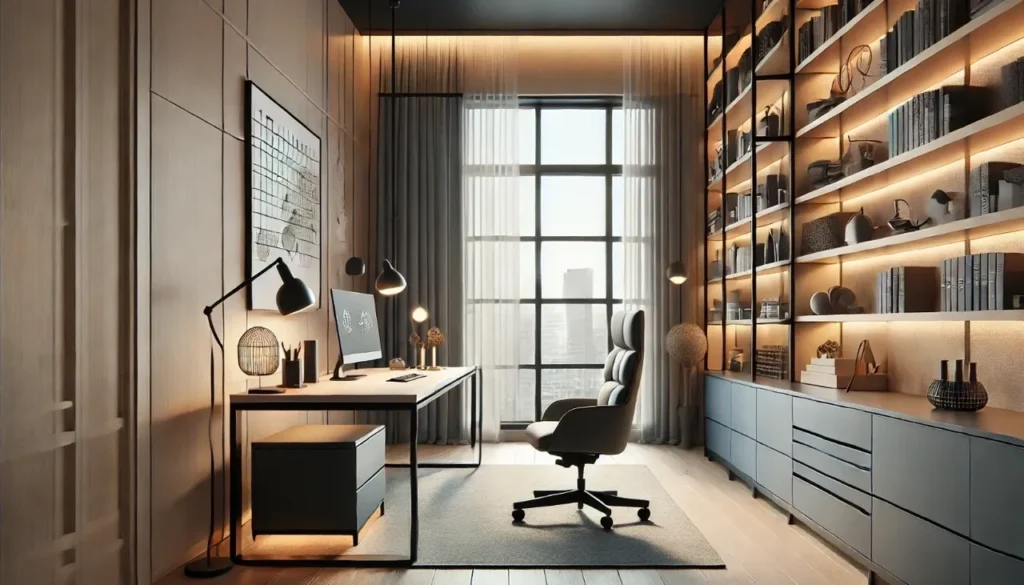The rise of remote work and hybrid schedules has made home offices a key part of modern living. Today’s home office designs blend functionality with aesthetics, creating spaces that inspire productivity while fitting seamlessly into home environments. Here are the latest trends and styles in home office design that cater to both practicality and personal style.
Multi-Functional Spaces
Many homeowners are opting for spaces that serve dual purposes. Home offices are now being integrated into living rooms, bedrooms, or kitchens using clever design techniques.
Foldable or Modular Furniture: Desks that fold away or convert into cabinets save space while keeping the area tidy.
Hidden Workspaces: Built-in desks within closets or cabinets offer a neat way to transform any corner into a productive zone.
Zoning: Rugs, shelving, or room dividers are being used to visually separate the work area from the rest of the room.
Biophilic Design
Incorporating elements of nature into home offices has become increasingly popular. Biophilic design promotes well-being and reduces stress by connecting the indoors with the outdoors.
Natural Materials: Wood, stone, and bamboo are often used in furniture and decor.
Indoor Plants: Adding greenery such as succulents, ferns, or peace lilies creates a refreshing and calming environment.
Maximized Natural Light: Large windows, light-colored walls, and reflective surfaces enhance natural light in workspaces.
Minimalist Aesthetics
The “less is more” approach is perfect for home offices, emphasizing a clean and clutter-free environment to boost focus and creativity.
Neutral Palettes: Shades like white, beige, gray, and muted pastels dominate minimalist home offices.
Streamlined Furniture: Sleek, simple desks and chairs with clean lines are the go-to choice.
Hidden Storage: Drawer units, shelves, and cabinets keep items out of sight for an organized look.
Smart Technology Integration
Smart technology is transforming home office setups, making them more efficient and ergonomic.
Smart Desks: Height-adjustable desks cater to both sitting and standing work positions.
Voice-Controlled Devices: Smart assistants like Alexa or Google Home manage lighting, temperature, and reminders.
Cable Management: Wireless chargers, concealed outlets, and cable organizers maintain a neat workspace.
Ergonomic Furniture
Comfort is a top priority for home offices, leading to a surge in ergonomic designs.
Supportive Chairs: Adjustable chairs with lumbar support and armrests are must-haves.
Sit-Stand Desks: These desks promote better posture and reduce sedentary behavior.
Footrests and Wrist Supports: Accessories that prioritize user health are gaining traction.
Bold and Personal Decor
Home offices are becoming an extension of personal style. Homeowners are customizing their spaces to reflect their tastes and inspire creativity.
Accent Walls: Wallpaper or bold paint colors add character to the office.
Gallery Displays: Art, photos, or motivational quotes are arranged to personalize the space.
Statement Lighting: Pendant lights, sconces, or stylish desk lamps double as decor.
Sustainability and Eco-Friendly Choices
Sustainability is a significant consideration in home office design, with a focus on reducing environmental impact.
Reclaimed Materials: Desks and shelves made from recycled wood or other upcycled materials are in demand.
Energy-Efficient Lighting: LED bulbs and solar-powered devices are both practical and eco-conscious.
Color Psychology in Design
Designers are leveraging the psychological impact of colors to create productive and inspiring spaces.
Calming Colors: Blue and green shades promote focus and tranquility.
Energizing Hues: Pops of yellow, orange, or red can stimulate creativity and enthusiasm.
Monochromatic Themes: Consistent color schemes create a cohesive and sophisticated look.
Tech-Free Zones
Some home offices are designed with intentional “tech-free” areas to encourage mindfulness and creativity.
Meditation Corners: Small nooks with cushions or yoga mats for relaxation breaks.
Analog Tools: Whiteboards, corkboards, or notepads foster creative brainstorming without screens.
Decorative Touches: Adding books, candles, or tactile items enhances a sense of calm.
Hybrid-Friendly Spaces
With many people working part-time from home, flexible home office designs accommodate varying needs.
Portable Furniture: Rolling desks and chairs that can be easily moved or stored.
Pop-Up Workstations: Compact desks that unfold when needed.
Shared Spaces: Designs that balance professional workstations with communal living spaces.
The latest trends in home office design focus on adaptability, comfort, and individuality. Whether you’re designing a dedicated office or carving out a corner in a shared space, these trends can help you create a workspace that is functional, stylish, and conducive to productivity.

